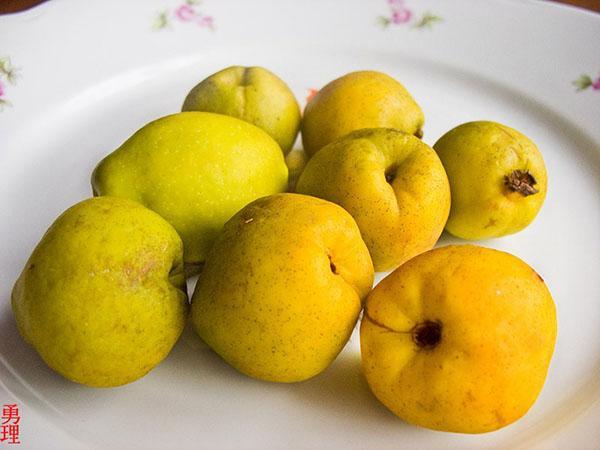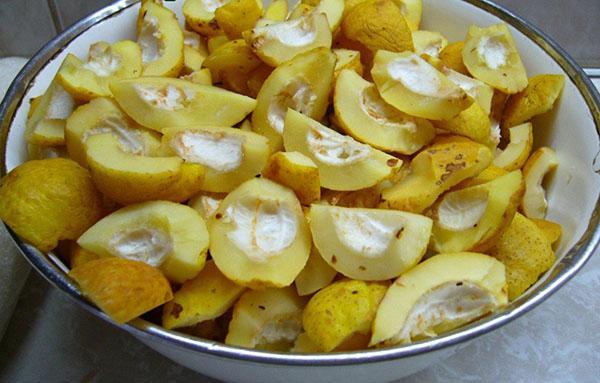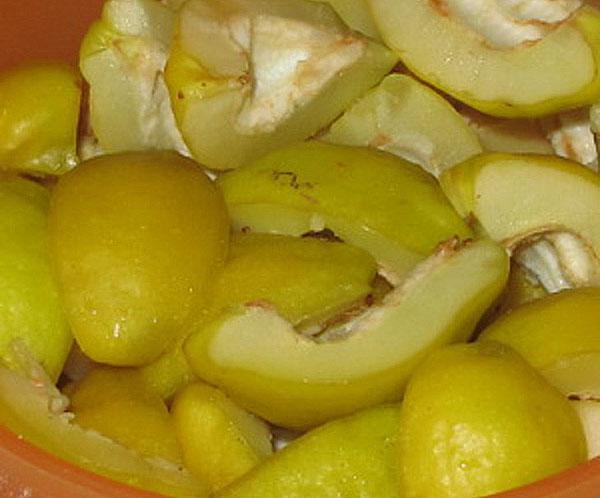Recipes for preparing blanks from Japanese quince for the winter
 Cooking recipes Japanese quince for the winter they are used as an intermediate stage for working with this fruit. The exotic fruit that looks like apples is very hard and sour, so it is practically unsuitable for consumption when raw. But jam can be used for baking, decorating desserts, and even simply added to tea.
Cooking recipes Japanese quince for the winter they are used as an intermediate stage for working with this fruit. The exotic fruit that looks like apples is very hard and sour, so it is practically unsuitable for consumption when raw. But jam can be used for baking, decorating desserts, and even simply added to tea.
Read also the article in the topic: simple recipe for quince jam!
Secrets of working with Japanese quince

- Before use, the fruit must be pitted. But you don't have to throw them away. On these seeds, you can make a medicinal tincture with a bright fruit aroma.
- Except for the seeds and the inside, the exotic apple does not need to be peeled. The peel and flesh are equally dense, so the shell will not interfere with preparing the blank for the winter.
- Whole fruits are never used in Japanese quince recipes. Even if you plan to make compote, you need to cut the quince into pieces.

- To prepare dishes from Japanese quince, you will need sugar, which can hide excessive sourness, and will also help the semi-finished product to last longer. However, it is not necessary to follow the exact proportions of the recipe. If you like sweets, you can add more sugar.
Quince blanks are very fragrant, so you need to store them in a tightly sealed container. Dishes are best preserved after heat treatment, but some recipes involve the use of raw parts.
How to make jam?
 Despite the sour taste and fibrous pulp, quince jam recipes are no different from jams made from other fruits. Before cooking, you need to sort out exotic apples, cut off the rotten parts, if any, wash the fruits and remove the inside. And then the flight of fantasy begins.
Despite the sour taste and fibrous pulp, quince jam recipes are no different from jams made from other fruits. Before cooking, you need to sort out exotic apples, cut off the rotten parts, if any, wash the fruits and remove the inside. And then the flight of fantasy begins.
Japanese quince in syrup
 The traditional recipe for making Japanese quince for the winter, which will require:
The traditional recipe for making Japanese quince for the winter, which will require:
- quince fruits, cut into wedges, cubes or small pieces;
- sugar in a ratio of 3: 2, where the smaller part is fruit;
- water, for every kilogram of fruit - 3 glasses of water.
The syrup is prepared first. To do this, add sugar to the water and put on medium heat. The liquid must be constantly stirred until the sugar is completely dissolved. As soon as the syrup boils, you can dip the fruit pieces into it.
 The fruit in the syrup should boil over medium heat, after which the container with the jam is removed from the stove and cooled at room temperature for 3-4 hours. A sufficiently cooled dish is returned to the stove over medium heat and brought to a boil. The procedure with cooling and bringing to a boil is carried out only 4 times. For the fifth time, the jam can be boiled for several minutes so that the fruits become soft enough, but do not turn into gruel. To enhance the aroma, you can add ½-1 lemon, crushed with the peel, to the syrup. And at the last digestion, you can add a pinch of vanillin.
The fruit in the syrup should boil over medium heat, after which the container with the jam is removed from the stove and cooled at room temperature for 3-4 hours. A sufficiently cooled dish is returned to the stove over medium heat and brought to a boil. The procedure with cooling and bringing to a boil is carried out only 4 times. For the fifth time, the jam can be boiled for several minutes so that the fruits become soft enough, but do not turn into gruel. To enhance the aroma, you can add ½-1 lemon, crushed with the peel, to the syrup. And at the last digestion, you can add a pinch of vanillin.
 Hot jam is laid out on dry sterilized jars and rolled up. It is necessary to store the workpiece in a dark place without drafts. Until it cools completely, the jars of jam can be covered with an old blanket or blanket.
Hot jam is laid out on dry sterilized jars and rolled up. It is necessary to store the workpiece in a dark place without drafts. Until it cools completely, the jars of jam can be covered with an old blanket or blanket.
Five minutes without heat treatment
 Five-minute jam is that recipe from Japanese quince for the winter, which is used only to flavor tea.Since the fruit itself remains too tough and sour to add to desserts. For five minutes you will need:
Five-minute jam is that recipe from Japanese quince for the winter, which is used only to flavor tea.Since the fruit itself remains too tough and sour to add to desserts. For five minutes you will need:
- thin slices of quince;
- sugar in a 1: 1 ratio.
Quince slices are sprinkled with sugar: a layer of fruit, a layer of sugar. And so on until the bank is full. The last layer will be sugar. The jam is kept in the refrigerator all winter. It is advisable to remove the first sample not earlier than after 2-3 days, when the quince starts up the juice and mixes it with sugar. Instead of quince slices, you can take exotic apple puree. But candied puree is still not good for desserts.
Honey and spicy jam
 An interesting option for what to do with the fruits of Japanese quince is a tasty and healthy honey jam. For such a dish you will need:
An interesting option for what to do with the fruits of Japanese quince is a tasty and healthy honey jam. For such a dish you will need:
- small pieces of quince or fruit puree;
- sugar in a 1: 1 ratio;
- honey in a ratio of 1: 2, where most are sour fruits;
- spices: cardamom, cinnamon, nutmeg.
 Quince is sprinkled with sugar. In this state, it should stand for about 2 hours. During this time, the fruit will juice up, so the jam will have its own syrup and no water is required. The mixture of fruit and sugar is distributed over the jars so that they are ¾ full.
Quince is sprinkled with sugar. In this state, it should stand for about 2 hours. During this time, the fruit will juice up, so the jam will have its own syrup and no water is required. The mixture of fruit and sugar is distributed over the jars so that they are ¾ full.
A towel is laid out in a large saucepan at the bottom, and jars of jam are exposed. Then you need to pour water so that it reaches the hangers of the cans. In this state, on low heat, the jam is pasteurized 15 minutes after the water boils. Honey is poured into hot jars and spices are added, after which you can close the jars and leave them to “rest”. Together with quince, you can add pieces of ordinary apples to the jars.
Compote
 To prepare a quince compote for the winter, you will need a fairly large number of fruits. They hardly give up their taste and aroma, so the jar is half filled with fruits. In addition to fruits, you will need:
To prepare a quince compote for the winter, you will need a fairly large number of fruits. They hardly give up their taste and aroma, so the jar is half filled with fruits. In addition to fruits, you will need:
- water;
- sugar in the ratio of 200-300 g per 1 liter of water.
Before distributing the quince among the banks, boil it a little. For this, fruits are dipped into boiling water for 2 minutes. This can be done in a colander so that there are no problems with drying the fruit. The water can later be used to create syrup.
 When boiled quince is packaged in jars, you need to prepare a syrup. Over low heat, water and sugar are brought to a boil. The liquid is immediately poured into fruit jars, after which they can be rolled up and left to cool.
When boiled quince is packaged in jars, you need to prepare a syrup. Over low heat, water and sugar are brought to a boil. The liquid is immediately poured into fruit jars, after which they can be rolled up and left to cool.
Also among the recipes for making Japanese quince for the winter can be found marmalade, jelly, juice, extract and many other dishes. All of them are very aromatic and with a noticeable sourness. In order to make the taste more unusual, it is recommended to mix the fruits with other fruits and berries, add lemon juice. But you should not completely replace sugar with honey if you have already decided what to cook from Japanese quince. When heat-treated fruits, such a replacement will have a bad effect on the state of the honey and the taste of the dish itself.
Read also the article:seedless cherry jam for the winter a simple recipe!